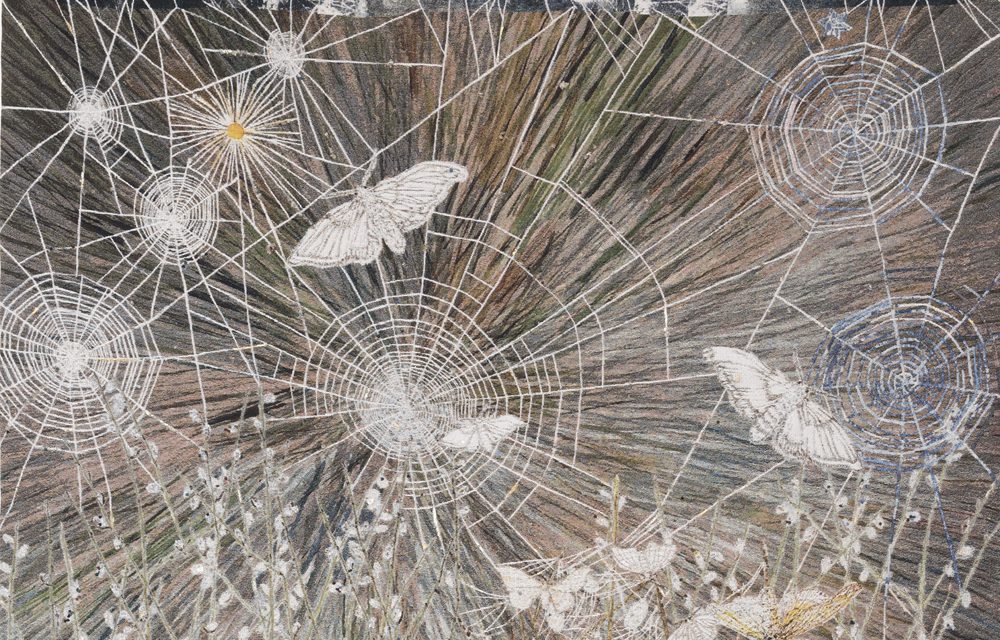Marking the final weekend of our Kiki Smith exhibition with her blog post is Modern Art Oxford volunteer and Oxford University DPhil candidate in English, Kitty Gurnos-Davies. Kitty’s research involves exploring women and materiality in contemporary theatre. In this new piece for us, she investigates the collaborative spirit running throughout Kiki Smith’s art practice.
Although I am a Wanderer is a solo exhibition of Kiki Smith’s work (the first of its kind in a UK public institution for 20 years), her conviction in the importance of collaboration is foregrounded. The collaborative spirit of her work is perhaps most evident in the themes that run through the pieces brought together across four rooms. Using diverse media – including prints, Jacquard tapestries, photographs, and small-scale sculptures – Kiki Smith reconceptualises the relationship between humans and the natural world. With under a week before the show closes at Modern Art Oxford, I revisit the exhibition to investigate how other traces of collaboration are evidenced in the work on display.
The tactility of Kiki Smith’s pieces invites us to engage, not only with the themes of her work, but the materiality of the art objects themselves; from the texture of the Nepalese paper used for her prints, to the seemingly gelatinous appearance of an egg yolk made of glass, and the oxidized surfaces of her cast iron sculptures, Woman and Sheep. The range of materials and techniques employed in the works gesture to the artists, artisans, and craftspeople she collaborates with to materialise her artistic vision.

Kiki Smith: I am a Wanderer, Modern Art Oxford, 2019. Photo by Ben Westoby
Collaborative art-making provided the context for Kiki Smith’s printmaking in the 1980s when she worked as part of the co-operative, Collaborative Projects Inc. (Colab), when they were operating in downtown New York. However, with a background in costume making, I am particularly interested in her more recent collaboration formed to produce a series of Jacquard tapestries that open the exhibition. Textile art has long been a subversive site of activism employed by women artists. While it has historically been marginalised from the lofty domain of ‘fine art’ – devalued in its association with craft and the decorative arts – artists such as Faith Ringgold (b. 1930) have taken up the traditionally ‘feminine’ skills of needlework and textile construction to disseminate powerful social critiques. Her series of ‘story quilts’, for example, redress the power-imbalances embedded in Western depictions of African American experiences.
The large-scale tapestries displayed in I am a Wanderer are similarly manifestations of Kiki Smith’s political urgency. Her subject is the reconceptualisation of human interactions with the natural world in the face of the impending ecological crisis. She models solidarity between her female figures and the animals that populate the twisting tree branches that stretch across many of her textile works. In Congregation, this solidarity is physicalized using interconnecting lines that spring forth from the eyes of a woman, squirrel, deer, and other woodland animals, connecting them together in a non-hierarchical network. Eyes reappear across her tapestries – blinking on the limbs of her figures, animating clover, and peering out from the twisted branches of trees. The eyes are gathered at eye-level so that the viewer find their gaze met by the artworks, inviting them to participate in the collaborative relationship Kiki Smith champions between animals, humans, and the natural world.

Cotton Jacquard Tapestry
Courtesy Timothy Taylor, London/New York
Kiki Smith collaborated with the fine art studio, Magnolia Editions, to digitally scan her designs for the tapestries. She created 1:1 scale cartoons (designs) for each tapestry by collaging her paper lithographs and drawings. These were then woven on electronic Jacquard looms in Belgium. Consequently, the tapestries presented in the exhibition bear the traces of the hand-worked processes employed in the collaged designs – the torn edges of paper, the scratching of a pen. Yet, when woven, the splashes of colour that bleed into one another in her prints appear almost pixilated, reminding us of the aesthetic impact of the digital technologies she employs. In turn, some of the tapestries bear ink drawings or gold leaf added once they had been constructed, reintroducing the hand of the artist to the object. The collaboration that Kiki Smith models in the creation of her tapestries thus encompasses the artistry of (human) individuals while extending to incorporate digital technologies.
Revisiting the production processes of her art works consequently offers us another glimpse into how collaboration remains at the heart of Kiki Smith’s artistic practice; thematically in her entanglement of humans, animals, and the natural world, formally in the making of the pieces, and experientially in the visitor’s encounter with her work in the exhibition space.

Kitty Gurnos-Davies is a DPhil candidate in English researching women and materiality in contemporary theatre. She also volunteers at Modern Art Oxford.
Find out more about Kiki Smith: I am a Wanderer here.
Discover more about volunteering at Modern Art Oxford on our volunteers page.
